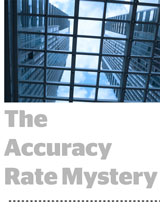 Solutions that analyze various data points such as device types, location data from an ad request, operating systems and other data to evaluate matches between users and devices are gaining traction. For instance, AdMobius, which offers probabilistic solutions, is rumored to be an acquisition target.
Solutions that analyze various data points such as device types, location data from an ad request, operating systems and other data to evaluate matches between users and devices are gaining traction. For instance, AdMobius, which offers probabilistic solutions, is rumored to be an acquisition target.
But pinning down the accuracy rate of probabilistic solutions continues to be challenging.
AdTruth, (which was recently acquired by Experian) uses what it calls its “universal device-recognition technology” to create AdTruth IDs for mobile devices, which it uses to estimate whether it is seeing the same user across mobile devices.
Karen Dayan, VP of corporate marketing at AdTruth, said these IDs are based on nonpersonally identifiable information (PII) and pegs AdTruth’s ability to correctly link users with devices between 80% and 90%.
This rate depends on a number factors such as the device type, operating system, and location, according to product manager Dilip Ramachandran. “There is no single performance that can be used to define the accuracy rate,” he said. “Each case is different.”
Other industry experts gave similar responses in regards to the accuracy of cross-device recognition solutions. During a panel discussion at AdExchanger’s Industry Preview conference, panelists Kamakshi Sivaramakrishnan of cross-device recognition firm Drawbridge, Nadya Kohl, VP of global strategy and business development at Experian Marketing Services, and DataXu CTO Bill Simmons, estimated accuracy rates ranged from 50% to 80%.
Simmons and Kohl both suggested that because cross-device recognition methods were still emerging, the chances of a solution making a correct match were still generally low at 50% or 75%, respectively.
Sivaramakrishnan was the most optimistic and maintained that Drawbridge’s solution could reach an 80% accuracy rate in some cases, but did not specify what circumstances were necessary to reach that rate.
Probabilistic solutions will never be 100% accurate, said Aaron McKee, CTO at ad retargeting firm Struq (an AdTruth client). Struq combines AdTruth’s technology with its own tracking abilities to help marketers serve personalized ads.
“Any probabilistic device fingerprinting approach is going to have a glass ceiling on accuracy,” McKee said. “Frankly, there’s not a lot that can be used to distinguish various iPhone 5s from each other, when they show up from the same location and you’re not using cookies or device IDs.”
Despite those limitations, AdTruth’s algorithm or technology is useful in a number of ways, McKee explained.
“The most important question for a device fingerprinting technology … is how many people are using it?” he said. “A fingerprint is only useful to us if we can use it to discover behavior on an advertiser’s site, intelligently buy media using the ID and then personalize an ad based on connecting all of these dots.”
AdTruth, according to McKee, met Struq’s requirements by “doing what it says it does” and working with numerous partners (AdTruth’s partner roster includes Adform, BlueKai, InMobi and OpenX). AdTruth said it has approximately 70 clients who have adopted its device-recognition solution.
Even though a probabilistic solution might never be 100% accurate, vendors are also positioning it as a less intrusive approach to tracking and targeting consumers.
AdTruth general manager and VP James Lamberti, for example, wants to steer clear of describing the company’s offerings as “fingerprinting.”
“There’s a difference between fingerprinting, which drops a permanent ID on a device and versus device recognition, which we do,” Lamberti said. “Fingerprinting is a ‘black hat’ thing while we’re probabilistic in nature.”














